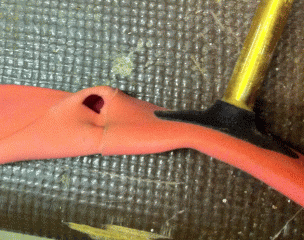Latex inner tubes: blessing or curse?
After much pondering, and recommendations from fellow cyclocross racers, I decided to give latex tubes a go in my clincher tyres. You wouldn't expect that an inner tube could make much difference, but the opinion is that latex gives a much more responsive ride than regular butyl tubes.
After a single cyclocross race riding a pair of Vittoria latex tubes, I can safely say that the ride was unmistakenly more grippy and responsive - especially on tight, off-camber wet grass. At the same time the power transfer was there to keep me moving up steep muddy slopes. However, my rear tube blew out after only a few minutes of racing, on a simple flat grass section, and I had run to the pits and switch to a regular wheel.

Later inspection of the blown tube revealed the major failure, pictured here. The tube had blown on the rim side. The hole looks like it's caused by the tube being forced through a hole in the rim (eg, rim tape failure), but this is on a Mavic Ksyrium wheel, with all-metal rim surface. Inspection of the wheel's rim surface shows no imperfections whatsoever. Inspection of the latex tube in the front wheel (which stayed up throughout the race) showed a bulging of the tube in the same location as the failure in the other tube. In both cases this location is just next to the join, where the two ends of the tube are overlapped and sealed together.
Punctures are an accepted, unfortunate part of cycling, but tube failures are not. These latex inner tubes aren't cheap, and it's very frustrating to lose several places in a race simply because one of them popped. Latex tubes are worth it for the ride alone, but not if they're going to explode due to poor construction.

